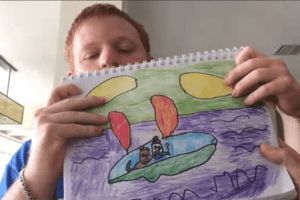January 12, 2020
. . .

Before Covid-19, Creative Clay’s Community Arts Program served 50 individuals with neuro-differences, ages 18 and older, Monday through Friday. According to the Centers for Disease Control, some people with disabilities might be at a higher risk of infection or severe illness because of their underlying medical conditions. Therefore, the population served is inherently at greater risk of contracting Covid-19.
The greatest impact of COVID-19 is that Creative Clay’s Community Arts Program closed indefinitely, isolating member artists from the program and the community. All operations went virtual. Staffers worked from home. The organization launched online gallery exhibits. Member artists sold art online. While many businesses reopened in late spring, Creative Clay remained closed, out of an abundance of caution and to protect the vulnerable artists served through its programs.
According to Cornell University’s 2017 Disability Report, people with disabilities experience joblessness, isolation, abuse. Creative Clay’s programs addressed these problems by creating a safe and inclusive artmaking space for artists with disabilities. Their artwork is sold in Creative Clay’s Good Folk Gallery and placed in offices, galleries and museums. Producing and selling artwork gives member artists a sense of identity that creates equity and connects them to the community.
According to The Disability Scoop News, a review of private health insurance claims data for 467,773 people diagnosed with the coronavirus in the U.S. between April and August finds that individuals with developmental disorders are three times more likely to die compared to others.
A National Public Radio (NPR) story stated that individuals with disabilities are four times more likely to die from COVID-related complications. “The high rate of death is disturbing, but it’s not surprising,” said Scott Landes, an associate professor of sociology at Syracuse University’s Maxwell School of Citizenship and Public Affairs.
Landes has been collecting data from state and private research groups and says people with developmental disabilities who live in group homes have some of the highest death rates from COVID-19 in the country.
“They’re more likely — four times more likely, we’re showing — to actually contract COVID-19 than the general population,” he said. “And then if they do contract COVID-19, what we’re seeing is they’re about two times more likely to die from it.”
On March 19, 2020, Creative Clay was forced to close its physical location and cease regular programming due to COVID-19. The St. Petersburg non-profit’s two largest programs, Community Arts and the Art Around the World inclusive summer camp, were closed. The organization also canceled live fundraising events and their monthly ArtWalk gallery exhibit openings on the second Saturday of each month.
When so many were losing their livelihoods, Creative Clay pivoted and partnered to create Creative Clay Connects. On May 1, 2020, the virtual art program was launched with a donation from Creative Clay board member Hal Freedman and Willi Rudowsky, with a 1/3 match grant from the Community Foundation of Tampa Bay. Several other Creative Clay board members and donors followed suit to support the program so that artists could stay connected and remain creative during this time. The generosity of the community enabled the non-profit to purchase art kits for all participants as well as to pay teaching artists.
While many were adjusting to working remotely and sitting through numerous virtual meetings as a new way of working amid a pandemic, Creative Clay artists embraced the use of technology as a new way to learn and create. Partnerships with local businesses and other creatives challenged the artists to make new art in various mediums, with all collaboration taking place through a new online platform.
Community partners such as the marketing department of Raymond James commissioned 170 portraits by Creative Clay artists. The First Night St. Pete poster design commission invited artists to create the image for the 2020 button. Participating in the play “Wordy” by Sheila Cowley kept artists and teachers excited and focused on lessons on portrait drawing, illustration and design. Creative Clay artists submitted illustrations for a children’s book, “Splish Splash,” which is also an audio play created by Sheila Cowley, Jim Rayfield and their creative team. [Disclaimer: Sheila Cowley serves as Managing Editor of the Arts Coast Journal.]

In August 2020, Creative Clay began Phase 1 of its reopening with its Pinellas County Schools Transition Program only. This reopening has been successful because of the protocols implemented by Pinellas County Schools. The physical space at Creative Clay’s facility in the Grand Central District of St. Petersburg is also conducive to social distancing. The Transition students began hosting a socially distanced outdoor First Friday Art Market in October 2020, featuring original art, live music, a food truck and mandatory mask-wearing.
Creative Clay’s vision is to make the arts accessible to all. Our mission is to help people with disabilities achieve full and inclusive lives through access to the arts by providing expressive, educational, and vocational experiences.
Creative Clay’s core program is its Community Arts Program, which serves 50-60 adult artists with neuro-differences each week. Through the implementation of additional offerings–such as the inclusive Art Around the World summer camp, Summer Studio for older teens and young adults, Artlink employment program, Creative Care Arts in Wellness outreach program, and its Pinellas County Schools’ partnership Transition program–individuals of all ages and abilities are mentored, taught and empowered to become working artists who actively create, market and sell their work. The result is that a formerly stigmatized population, through the art it makes and sells, demystifies stereotypes surrounding those with disabilities and creates a culture of acceptance throughout the community.
Follow Creative Clay on Facebook, on Instagram @creativeclaystpete, on Twitter @creativeclay and on LinkedIn.
– Kerry Kriseman, Public Relations Manager for Creative Clay




